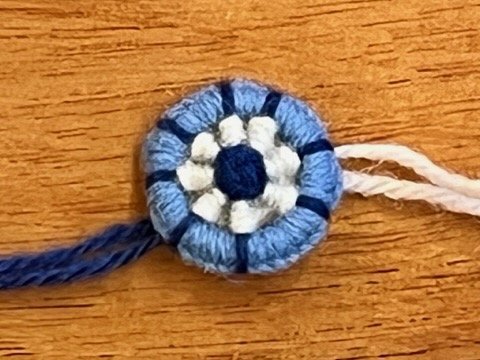
ABOUT
-

Casting
Casting: covering the ring with the blanket stitch all around the perimeter to full envelope the ring
-

Laying
winding the yarn around the ring to create spokes at various intervals; secure at the center with cross stitches to finish off.
-

Rounding
Make a back stitch around each spoke, one at a time, to build up the middle. Continue backstitching around until each spoke is covered, filling in the center of the button. Secure.
Making Dorset Buttons
Buttons that were made by covering rings with thread have existed long before fabric covered buttons. Traditionally they were made with cotton or linen thread, and then from farm wool for a more rustic appeal. In more recent times, fancy threads such as metallic and specialty embroidery yarns have been used, and even applied beading.
There are many lovely Dorset style buttons, some traditional, some created and innovated throughout history. I particularly like the classic Cartwheel style. When done in three yarn colorations, playing with color contrasts can make a striking button. The variations are endless and the enjoyment in the making is infinite!
In my kits I have complete instructions and diagrams. Depending on the end use of the button, a shank can be applied to enable fitting through a buttonhole.
I use a metal shank of the covered button, sold commercially. For other decorative uses, the button can be applied by simply sewing into the threads of the back of the button to your item, or in some instances, can be glued on for decorative purposes.



